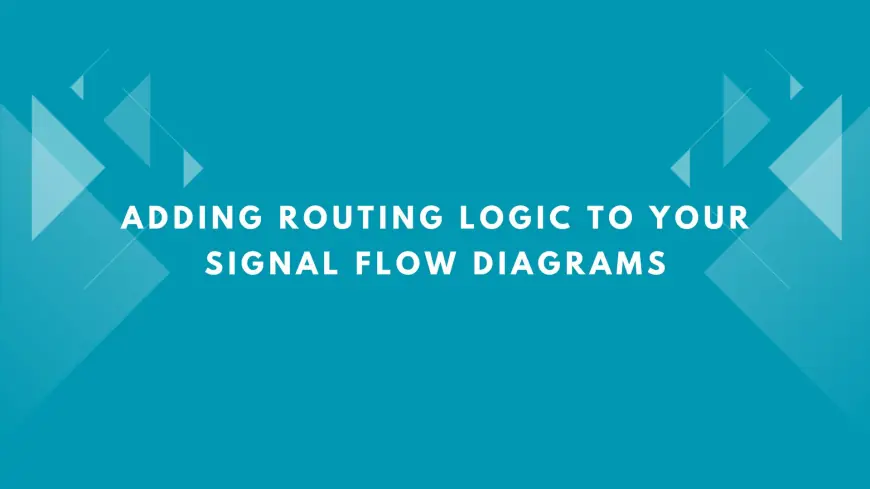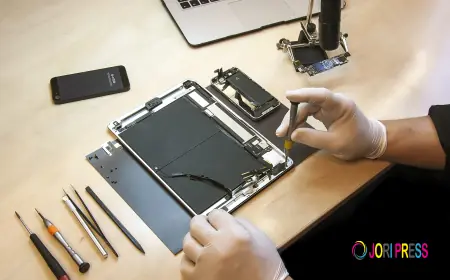Adding Routing Logic to Your Signal Flow Diagrams
In this blog, we’ll explore what routing logic is, why it matters in signal flow diagrams, and how XTEN-AV makes it easy to apply logical routing paths that improve system clarity, flexibility, and reliability.

In AV system design, a signal flow diagram is more than just a static drawing. It is a visual representation of how audio, video, and control signals move from one device to another. But to truly make these diagrams functional and intelligent, AV professionals need to go one step further—by adding routing logic. Routing logic defines how signals are switched, managed, and delivered across various paths within the system. With XTEN-AV, adding routing logic to your diagrams is fast, precise, and completely integrated into its advanced signal flow diagram software.
In this blog, we’ll explore what routing logic is, why it matters in signal flow diagrams, and how XTEN-AV makes it easy to apply logical routing paths that improve system clarity, flexibility, and reliability.
Why Routing Logic Matters in AV Design
In a basic diagram, you may show a direct connection between a source and a display. But in real-world AV systems, especially in environments like boardrooms, command centers, classrooms, or performance venues, signals rarely travel in a straight line. They may be routed through:
-
Matrix switchers
-
Video or audio processors
-
DSP units
-
AV over IP encoders and decoders
-
Control systems that automate switching based on events
This is where routing logic becomes essential. It answers key operational questions such as:
-
Which source is active on which display?
-
What happens when a user presses a control panel button?
-
How are fallback paths handled during a failure?
-
Which devices can share or isolate signals?
Routing logic brings clarity and operational purpose to your signal flow diagrams, ensuring the system behaves as expected under all conditions.
How XTEN-AV Simplifies Routing Logic
XTEN-AV is a leading platform for AV system design. Its signal flow diagram software includes built-in features for representing and managing routing logic. Instead of drawing extra lines or creating complex notations manually, you can use the software to visually define how signals are switched, prioritized, and triggered.
Here’s how you can build intelligent signal flow diagrams with routing logic using XTEN-AV.
Step 1: Design Your Base Signal Flow
Start by laying out your devices and connecting them with standard signal paths. In XTEN-AV, you can:
-
Drag and drop devices from the pre-loaded library
-
Automatically populate their ports and I/O options
-
Connect audio, video, and control lines with auto-detected signal types
-
Label connections and group devices by zone, rack, or room
This foundational diagram sets the stage for your routing logic.
Step 2: Identify Routing Points
Routing logic typically applies to devices that can accept multiple inputs and output to multiple destinations. These include:
-
Video matrix switchers
-
HDMI or HDBaseT switchers
-
Audio DSP units
-
AV over IP switch nodes
-
Control processors
In XTEN-AV, you can highlight these routing points and define input/output rules for each. For example:
-
Input 1 routes to Output A by default
-
Output B is prioritized for conferencing signals
-
Input 3 triggers auto-mute on Output C
Adding this level of detail shows not just physical wiring but also how signal decisions are made.
Step 3: Add Logic Notations and Path Labels
XTEN-AV allows you to overlay routing logic as part of the visual design. This includes:
-
Logic arrows to indicate dynamic routing
-
Labels to describe switching conditions or automation rules
-
Visual icons for manual or automated control paths
-
Branching lines for alternative routes or backup feeds
These notations help installers and clients understand how signal routing adapts in real time.
Step 4: Apply Layered Views for Simplicity
Routing logic can get complex, especially in larger systems. To keep your diagram readable, XTEN-AV offers layered views where you can separate:
-
Static wiring from dynamic routing
-
Audio routing logic from video paths
-
Control sequences from signal flow
By toggling layers, you can focus on one logical process at a time without cluttering the diagram.
Step 5: Use Templates and Presets for Common Routing Patterns
XTEN-AV includes smart templates and reusable blocks that help you apply common routing logic. For example:
-
Auto-switching logic when HDMI is connected
-
Room combining scenarios with shared AV sources
-
Priority routing for emergency audio systems
-
Load balancing across AV over IP encoders
These templates save time and improve consistency across projects.
Step 6: Validate Routing Logic with Built-In Rules
With traditional drawing tools, routing logic is theoretical. But in XTEN-AV’s signal flow diagram software, logic paths are validated automatically. The system checks:
-
Whether signal types match along the route
-
If the switcher supports the proposed input/output configuration
-
Conflicts in overlapping routes or control assignments
This ensures your routing logic is not just visually clear but technically sound.
Step 7: Export Routing Diagrams with Logic Notations
Once your routing logic is applied, XTEN-AV makes it easy to export the diagram in various formats:
-
PDF: For inclusion in proposals or client documentation
-
PNG: For presentations and quick visual references
-
DWG or CAD: For integration with architectural or engineering plans
-
Cloud sharing: So stakeholders can review logic paths collaboratively
Be sure to include a legend that explains routing logic symbols and conditions so the client or installer can interpret the diagram correctly.
Real-World Example: Corporate Conference Room
Consider a multi-use conference room with:
-
Two displays
-
A video conferencing codec
-
Wireless and wired input sources
-
An AV control processor
-
Audio DSP for microphone processing
Using XTEN-AV, you would create a signal flow diagram showing:
-
Default routing of laptop input to both displays
-
Switching logic when the room is divided or combined
-
Routing from the DSP to ceiling speakers based on source type
-
Control logic that adjusts routing automatically during calls
This complete logic-driven diagram becomes a central tool for installers, IT staff, and clients who need to understand how the system operates.
Conclusion
Routing logic is what turns a basic signal diagram into a true system design. It helps define how your AV system behaves under real-world conditions, enhances flexibility, and ensures reliability in operation. With XTEN-AV’s powerful signal flow diagram software, AV professionals can not only map devices and cables but also embed intelligent logic that reflects how the system functions.
Whether you are designing a single-room system or an enterprise-wide AV network, adding routing logic ensures your diagrams do more than show connections—they show purpose. And with XTEN-AV, that purpose is presented clearly, professionally, and with total confidence.
Read more: https://ekonty.com/blogs/338238/Annotating-Signal-Paths-for-Better-Understanding
What's Your Reaction?
 Like
0
Like
0
 Dislike
0
Dislike
0
 Love
0
Love
0
 Funny
0
Funny
0
 Angry
0
Angry
0
 Sad
0
Sad
0
 Wow
0
Wow
0



















































